
- •Study Skills Workshop
- •1.1 An Introduction to the Whole Numbers
- •1.2 Adding Whole Numbers
- •1.3 Subtracting Whole Numbers
- •1.4 Multiplying Whole Numbers
- •1.5 Dividing Whole Numbers
- •1.6 Problem Solving
- •1.7 Prime Factors and Exponents
- •1.8 The Least Common Multiple and the Greatest Common Factor
- •1.9 Order of Operations
- •THINK IT THROUGH Education Pays
- •2.1 An Introduction to the Integers
- •THINK IT THROUGH Credit Card Debt
- •2.2 Adding Integers
- •THINK IT THROUGH Cash Flow
- •2.3 Subtracting Integers
- •2.4 Multiplying Integers
- •2.5 Dividing Integers
- •2.6 Order of Operations and Estimation
- •Cumulative Review
- •3.1 An Introduction to Fractions
- •3.2 Multiplying Fractions
- •3.3 Dividing Fractions
- •3.4 Adding and Subtracting Fractions
- •THINK IT THROUGH Budgets
- •3.5 Multiplying and Dividing Mixed Numbers
- •3.6 Adding and Subtracting Mixed Numbers
- •THINK IT THROUGH
- •3.7 Order of Operations and Complex Fractions
- •Cumulative Review
- •4.1 An Introduction to Decimals
- •4.2 Adding and Subtracting Decimals
- •4.3 Multiplying Decimals
- •THINK IT THROUGH Overtime
- •4.4 Dividing Decimals
- •THINK IT THROUGH GPA
- •4.5 Fractions and Decimals
- •4.6 Square Roots
- •Cumulative Review
- •5.1 Ratios
- •5.2 Proportions
- •5.3 American Units of Measurement
- •5.4 Metric Units of Measurement
- •5.5 Converting between American and Metric Units
- •Cumulative Review
- •6.2 Solving Percent Problems Using Percent Equations and Proportions
- •6.3 Applications of Percent
- •6.4 Estimation with Percent
- •6.5 Interest
- •Cumulative Review
- •7.1 Reading Graphs and Tables
- •THINK IT THROUGH The Value of an Education
- •Cumulative Review
- •8.1 The Language of Algebra
- •8.2 Simplifying Algebraic Expressions
- •8.3 Solving Equations Using Properties of Equality
- •8.4 More about Solving Equations
- •8.5 Using Equations to Solve Application Problems
- •8.6 Multiplication Rules for Exponents
- •Cumulative Review
- •9.1 Basic Geometric Figures; Angles
- •9.2 Parallel and Perpendicular Lines
- •9.3 Triangles
- •9.4 The Pythagorean Theorem
- •9.5 Congruent Triangles and Similar Triangles
- •9.6 Quadrilaterals and Other Polygons
- •9.7 Perimeters and Areas of Polygons
- •THINK IT THROUGH Dorm Rooms
- •9.8 Circles
- •9.9 Volume
- •Cumulative Review
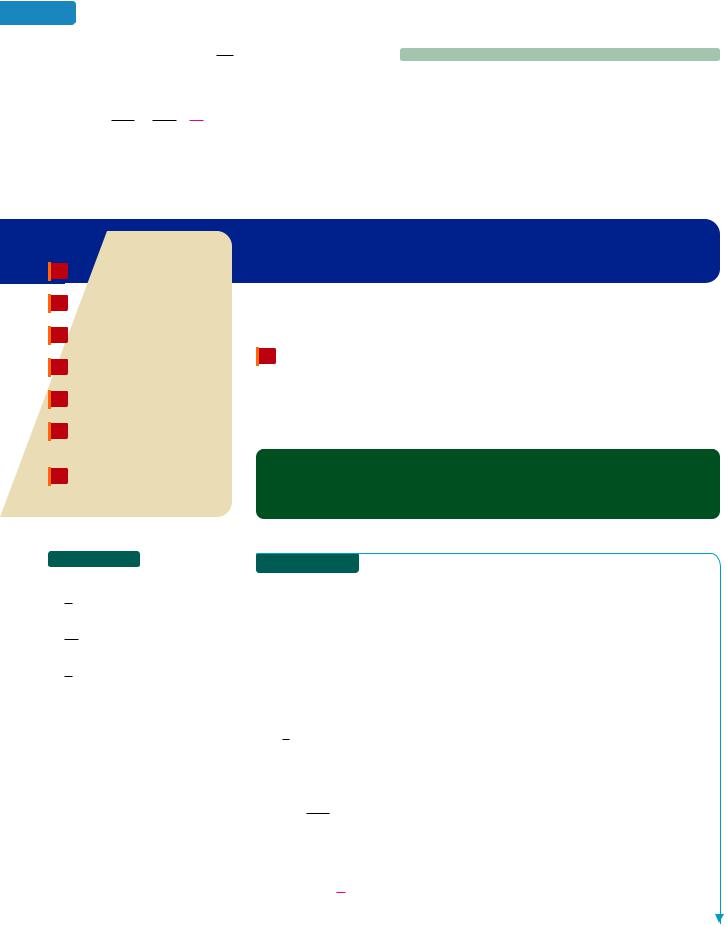
372 |
Chapter 4 Decimals |
112.Explain why multiplying 40.86.2 by the form of 1 shown below moves the decimal points in the dividend,
4.86, and the divisor, 0.2, one place to the right.
4.86 4.86110
0.2 0.2 10
 REVIEW
REVIEW
113.a. Find the GCF of 10 and 25.
b.Find the LCM of 10 and 25.
114.a. Find the GCF of 8, 12, and 16.
b.Find the LCM of 8, 12, and 16.
Objectives |
S E C T I O N 4.5 |
1Write fractions as equivalent terminating decimals.
2Write fractions as equivalent repeating decimals.
3Round repeating decimals.
4Graph fractions and decimals on a number line.
5Compare fractions and decimals.
6Evaluate expressions containing fractions and decimals.
7Solve application problems involving fractions and decimals.
Fractions and Decimals
In this section, we continue to explore the relationship between fractions and decimals.
1 Write fractions as equivalent terminating decimals.
A fraction and a decimal are said to be equivalent if they name the same number. Every fraction can be written in an equivalent decimal form by dividing the numerator by the denominator, as indicated by the fraction bar.
Writing a Fraction as a Decimal
To write a fraction as a decimal, divide the numerator of the fraction by its denominator.
 Self Check 1
Self Check 1
Write each fraction as a decimal. 1
a. 2
3
b.16
9
c.2
Now Try Problems 15, 17, and 21
|
EXAMPLE 1 |
Write each fraction as a decimal. |
||||||
3 |
5 |
|
7 |
|
||||
a. |
|
b. |
|
|
c. |
|
|
|
4 |
8 |
2 |
||||||
Strategy We will divide the numerator of each fraction by its denominator. We will continue the division process until we obtain a zero remainder.
WHY We divide the numerator by the denominator because a fraction bar indicates division.
Solution
a. 34 means 3 4. To find 3 4, we begin by writing it in long division form as 4 3. To proceed with the division, we must write the dividend 3 with a decimal point and some additional zeros. Then we use the procedure from Section 4.4 for dividing a decimal by a whole number.
0.75
4 3.00
2 8T 2020 0
Write a decimal point and two additional zeros to the right of 3.
The remainder is 0.
Thus, |
3 |
0.75. We say that the decimal equivalent of |
3 |
is 0.75. |
|
4 |
|
4 |
|
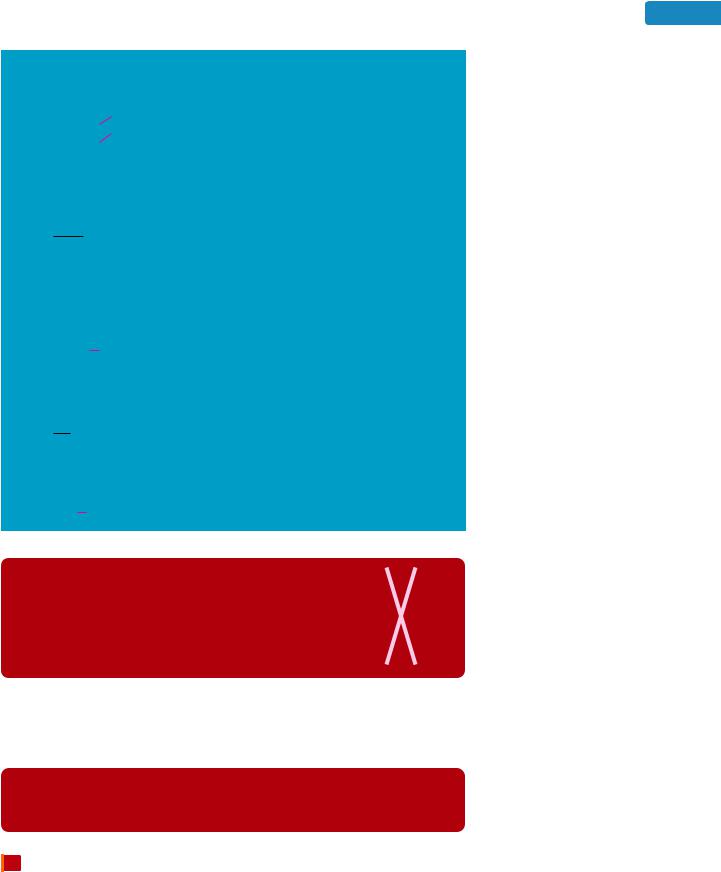
4.5 Fractions and Decimals |
373 |
We can check the result by writing 0.75 as a fraction in simplest form:
|
|
0.75 |
75 |
|
0.75 is seventy-five hundredths. |
|
|
|
100 |
|
|||
|
|
|
1 |
|
||
|
|
|
3 25 To simplify the fraction, factor 75 as 3 25 and 100 |
|||
|
|
4 25 |
as 4 25 and remove the common factor of 25. |
|||
|
|
|
1 |
|
||
|
|
|
3 |
|
|
This is the original fraction. |
|
|
|
|
|
||
|
|
4 |
|
|
||
b. |
5 |
means 5 8. |
|
|||
|
8 |
|
|
|
|
|
0.625
8 5.000 Write a decimal point and three additional zeros to the right of 5.
4 8
20
16
40
40
0
The remainder is 0.
Thus, 58 0.625.
c. 72 means 7 2.
3.5
2 7.0
6
1 0
1 0
0
Write a decimal point and one additional zero to the right of 7.
The remainder is 0.
Thus, 72 3.5.
Caution! A common error when finding a decimal equivalent |
1.6 |
|
for a fraction is to incorrectly divide the denominator by the |
5 |
8.0 |
numerator. An example of this is shown on the right, where the |
5 |
|
decimal equivalent of 85 (a number less than 1) is incorrectly |
3 0 |
|
found to be 1.6 (a number greater than 1). |
3 0 |
|
|
|
0 |
In parts a, b, and c of Example 1, the division process ended because a remainder of 0 was obtained. When such a division terminates with a remainder of 0, we call the resulting decimal a terminating decimal. Thus, 0.75, 0.625, and 3.5 are three examples of terminating decimals.
The Language of Mathematics To terminate means to bring to an end. In the movie The Terminator, actor Arnold Schwarzenegger plays a heartless machine sent to Earth to bring an end to his enemies.
2 Write fractions as equivalent repeating decimals.
Sometimes, when we are finding a decimal equivalent of a fraction, the division process never gives a remainder of 0. In this case, the result is a repeating decimal. Examples of repeating decimals are 0.4444 . . . and 1.373737 . . . . The three dots tell us
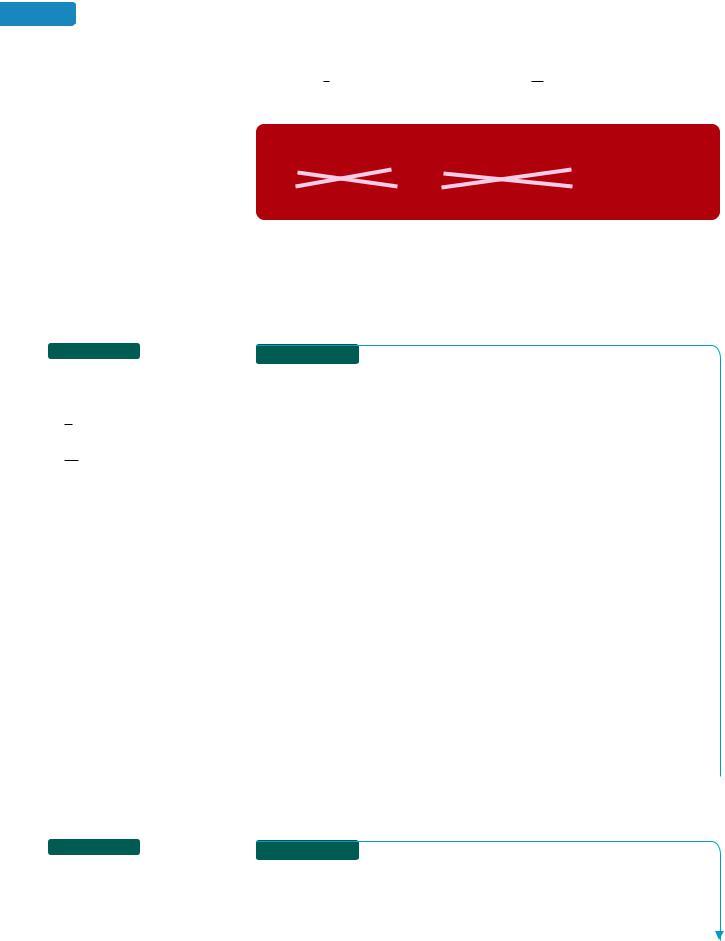
374 |
Chapter 4 Decimals |
that a block of digits repeats in the pattern shown. Repeating decimals can also be written using a bar over the repeating block of digits. For example, 0.4444 . . . can be written as 0.4, and 1.373737 . . . can be written as 1.37.
Caution! When using an overbar to write a repeating decimal, use the least number of digits necessary to show the repeating block of digits.
|
|
|
|
|
|
|
|
|
. . .0.333 |
0.333 |
. . .6.7454545 |
6.7454 |
|||||
0.333 |
|
|
|
6.7454545 |
|
|
|
|
0.3 |
|
6.745 |
|
|||||
 Self Check 2
Self Check 2
Write each fraction as a decimal using multiplication by a form of 1:
2
a. 5
8
b. 25
Now Try Problems 27 and 29
 Self Check 3
Self Check 3
Write the mixed number 31720 in decimal form.
Now Try Problem 37
Some fractions can be written as decimals using an alternate approach. If the denominator of a fraction in simplified form has factors of only 2’s or 5’s, or a combination of both, it can be written as a decimal by multiplying it by a form of 1. The objective is to write the fraction in an equivalent form with a denominator that is a power of 10, such as 10, 100, 1,000, and so on.
|
EXAMPLE 2 |
Write each fraction as a decimal using multiplication by a |
|||||
form of 1: |
4 |
|
11 |
|
|||
a. |
|
|
b. |
|
|
||
5 |
40 |
||||||
Strategy We will multiply 45 by 22 and we will multiply 1140 by 2525 .
WHY The result of each multiplication will be an equivalent fraction with a denominator that is a power of 10. Such fractions are then easy to write in decimal form.
Solution
a.Since we need to multiply the denominator of 45 by 2 to obtain a denominator of 10, it follows that 22 should be the form of 1 that is used to build 45 .
4 |
|
4 |
|
|
2 |
Multiply |
4 by 1 in the form of |
2 . |
|
5 |
5 |
|
2 |
||||||
|
|
|
|
|
5 |
2 |
|||
|
|
8 |
|
|
|
Multiply the numerators. |
|
||
|
|
|
|
|
|
|
|
|
|
10Multiply the denominators.
0.8 Write the fraction as a decimal.
b.Since we need to multiply the denominator of 1140 by 25 to obtain a denominator of 1,000, it follows that 2525 should be the form of 1 that is used to build 1140 .
11 |
|
1 |
|
|
|
|
|||
|
|
|
|
|
Multiply |
11 |
by 1 in the form of |
25 . |
|
40 |
|
40 |
|
25 |
|
40 |
|
25 |
|
|
|
|
|
|
|
|
|||
|
|
275 |
|
Multiply the numerators. |
|
|
|||
|
1,000 |
|
Multiply the denominators. |
|
|
||||
|
0.275 |
|
Write the fraction as a decimal. |
|
|||||
|
|
||||||||
|
|
||||||||
Mixed numbers can also be written in decimal form.
|
EXAMPLE 3 |
Write the mixed number 5 |
7 |
|
in decimal form. |
|
|
16 |
|
Strategy We need only find the decimal equivalent for the fractional part of the mixed number.
WHY The whole-number part in the decimal form is the same as the wholenumber part in the mixed number form.
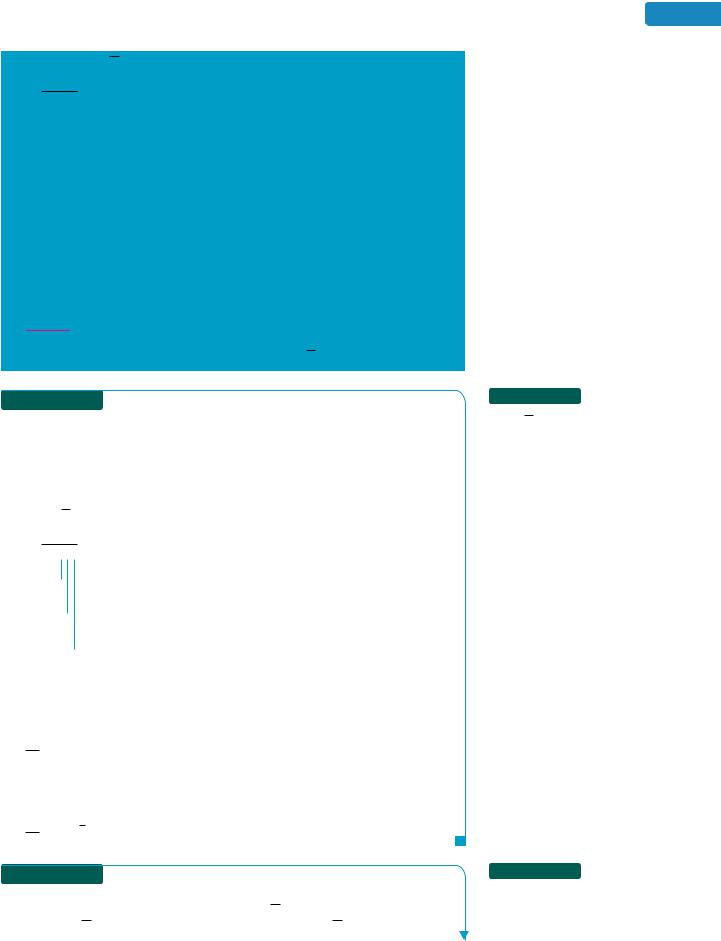
Solution To write 167 as a fraction, we find 7 16.
0.4375
16 7.0000 Write a decimal point and four additionl zeros to the right of 7.
6 4
6048
120112
8080
0 |
|
|
The remainder is 0. |
Since the whole-number part of the decimal must be the same as the whole-number part of the mixed number, we have:
5 |
7 |
5.4375 |
|
16 |
|||
c |
c |
||
|
We would have obtained the same result if we changed 5 167 to the improper fraction 8716 and divided 87 by 16.
|
EXAMPLE 4 |
Write |
5 |
as a decimal. |
|
|
12 |
Strategy We will divide the numerator of the fraction by its denominator and watch for a repeating pattern of nonzero remainders.
WHY Once we detect a repeating pattern of remainders, the division process can stop.
Solution 125 means 5 12.
0.4166
12 5.0000 Write a decimal point and four additional zeros to the right of 5.
4 8
2012
80
72
80
It is apparent that 8 will continue to reappear as the remainder. Therefore,72 6 will continue to reappear in the quotient. Since the repeating pattern is
8 now clear, we can stop the division.
We can use three dots to show that a repeating pattern of 6’s appears in the quotient:
125 0.416666 . . .
Or, we can use an overbar to indicate the repeating part (in this case, only the 6), and write the decimal equivalent in more compact form:
5
12 0.416
|
EXAMPLE 5 |
Write |
6 |
as a decimal. |
|
|
11 |
Strategy To find the decimal equivalent for 116 , we will first find the decimal equivalent for 116 . To do this, we will divide the numerator of 116 by its denominator and watch for a repeating pattern of nonzero remainders.
|
4.5 Fractions and Decimals |
375 |
|
|
|
|
|
|
 Self Check 4
Self Check 4
Write 121 as a decimal.
Now Try Problem 41
 Self Check 5
Self Check 5
Write 1333 as a decimal.
Now Try Problem 47
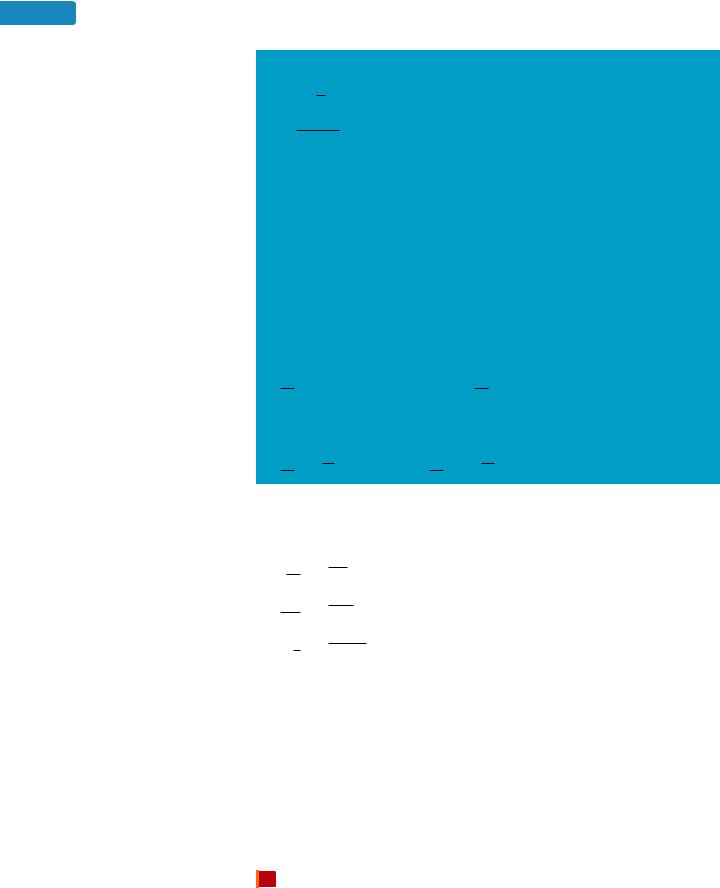
376 |
Chapter 4 Decimals |
WHY Once we detect a repeating pattern of remainders, the division process can stop.
Solution 116 means 6 11.
0.54545
11 6.00000
5 5
50
44
60
55
50
44
60
55
5
Write a decimal point and five additional zeros to the right of 6.
It is apparent that 6 and 5 will continue to reappear as remainders. Therefore, 5 and 4 will continue to reappear in the quotient. Since the repeating pattern is now clear, we can stop the division process.
We can use three dots to show that a repeating pattern of 5 and 4 appears in the quotient:
116 0.545454 . . . and therefore, 116 0.545454 . . .
Or, we can use an overbar to indicate the repeating part (in this case, 54), and write the decimal equivalent in more compact form:
116 0.54 and therefore, 116 0.54
The repeating part of the decimal equivalent of some fractions is quite long. Here are some examples:
9
37 0.243 A block of three digits repeats.
13
101 0.1287 A block of four digits repeats.
6
7 0.857142 A block of six digits repeats.
Every fraction can be written as either a terminating decimal or a repeating decimal. For this reason, the set of fractions (rational numbers) form a subset of the set of decimals called the set of real numbers. The set of real numbers corresponds to all points on a number line.
Not all decimals are terminating or repeating decimals. For example,
0.2020020002 . . .
does not terminate, and it has no repeating block of digits. This decimal cannot be written as a fraction with an integer numerator and a nonzero integer denominator. Thus, it is not a rational number. It is an example from the set of irrational numbers.
3 Round repeating decimals.
When a fraction is written in decimal form, the result is either a terminating or a repeating decimal. Repeating decimals are often rounded to a specified place value.
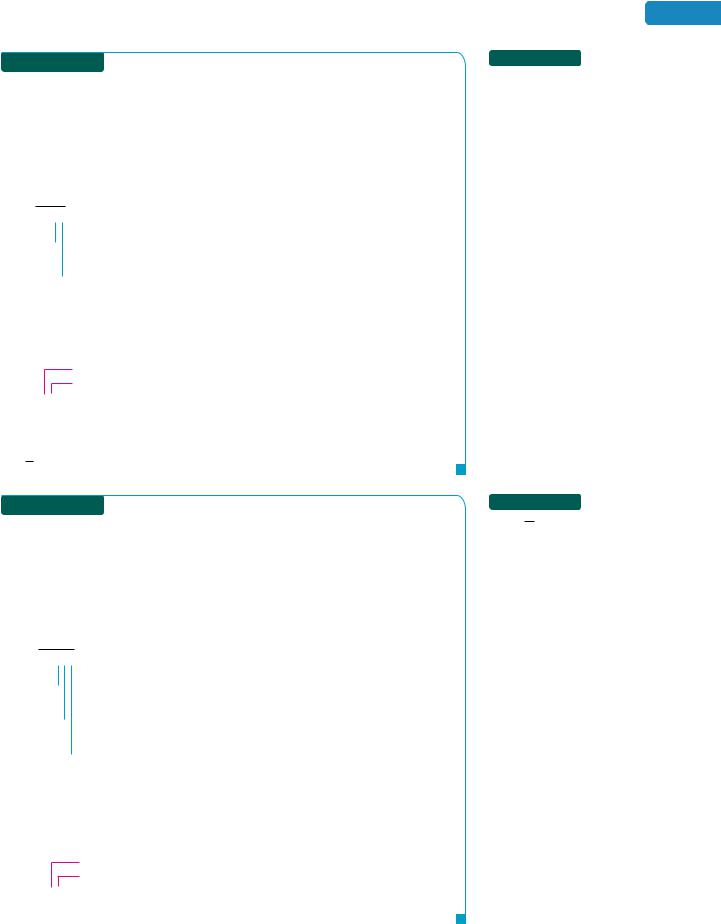
|
EXAMPLE 6 |
Write |
1 |
as a decimal and round to the nearest hundredth. |
|
|
3 |
||
|
|
Strategy We will use the methods of this section to divide to the thousandths column.
WHY To round to the hundredths column, we need to continue the division process for one more decimal place, which is the thousandths column.
Solution 13 means 1 3.
0.333
3 1.000 Write a decimal point and three additional zeros to the right of 1.
9
10
9
10
9
1 The division process can stop. We have divided to the thousandths column.
After dividing to the thousandths column, we round to the hundredths column.
The rounding digit in the hundredths column is 3.
The test digit in the thousandths column is 3.
0.333 . . .
Since 3 is less than 5, we round down, and we have
1
3 0.33 Read as “is approximately equal to.”
|
EXAMPLE 7 |
Write |
2 |
as a decimal and round to the nearest thousandth. |
|
|
7 |
||
|
|
Strategy We will use the methods of this section to divide to the ten-thousandths column.
WHY To round to the thousandths column, we need to continue the division process for one more decimal place, which is the ten-thousandths column.
Solution 27 means 2 7.
0.2857
7 2.0000 Write a decimal point and four additional zeros to the right of 2.
1 4
6056
4035
50
49
1The division process can stop.
We have divided to the ten-thousandths column.
After dividing to the ten-thousandths column, we round to the thousandths column.
The rounding digit in the thousandths column is 5.
The test digit in the ten-thousandths column is 7.
0.2857
Since 7 is greater than 5, we round up, and 27 0.286.
4.5 Fractions and Decimals |
377 |
 Self Check 6
Self Check 6
Write 49 as a decimal and round to the nearest hundredth.
Now Try Problem 51
 Self Check 7
Self Check 7
Write 247 as a decimal and round to the nearest thousandth.
Now Try Problem 61
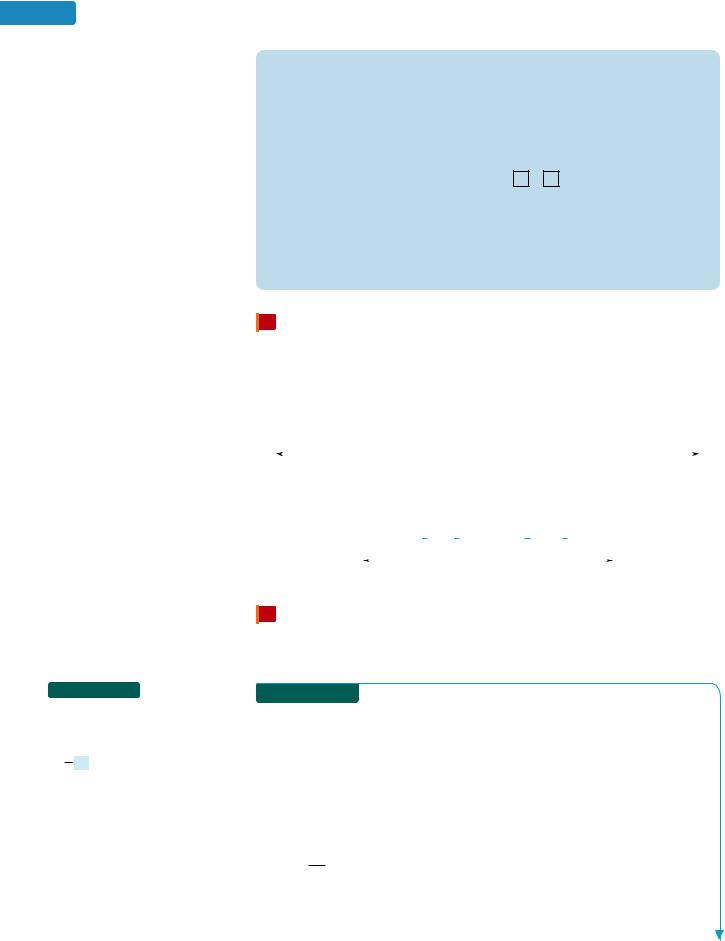
378 |
Chapter 4 Decimals |
 Self Check 8
Self Check 8
Place an , , or an symbol in the box to make a true statement:
3
a. 8 0.305
|
|
|
|
|
|
|
|
|
7 |
|
b. |
0.76 |
|
|
|
||||||
|
|
9 |
|
|||||||
|
11 |
|
|
|
|
|
|
|
||
c. |
|
|
|
|
|
2.75 |
||||
|
|
|
||||||||
|
|
|
|
|
|
|||||
4 |
|
|
|
|
|
|||||
|
|
|
||||||||
Now Try Problems 67, 69, and 71
Using Your CALCULATOR The Fixed-Point Key
After performing a calculation, a scientific calculator can round the result to a given decimal place. This is done using the fixed-point key. As we did in Example 7, let’s find the decimal equivalent of 27 and round to the nearest thousandth. This time, we will use a calculator.
First, we set the calculator to round to the third decimal place (thousandths)
by pressing |
2nd |
|
FIX |
3. Then we press 2 |
|
7 |
|
|
0.286 |
Thus, 27 0.286. To round to the nearest tenth, we would fix 1; to round to the nearest hundredth, we would fix 2; and so on. After using the FIX feature, don’t forget to remove it and return the calculator to the normal mode.
Graphing calculators can also round to a given decimal place. See the owner’s manual for the required keystrokes.
4 Graph fractions and decimals on a number line.
A number line can be used to show the relationship between fractions and their decimal equivalents. On the number line below, sixteen equally spaced marks are used to scale from 0 to 1. Some commonly used fractions that have terminating decimal equivalents are shown. For example, we see that 18 0.125 and 1316 0.8125.
|
.0625 .125 .1875.25 |
.3125 .375 .4375 . |
.5625 .625 .6875.75 |
.8125.875 .9375 |
||||||||||||||||||||||||||||
|
0 |
0 |
0 |
0 |
0 |
0 |
0 |
5 |
0 |
0 |
0 |
0 |
0 |
0 |
0 |
|
|
|||||||||||||||
|
0 |
|
|
|||||||||||||||||||||||||||||
|
|
|
|
|
|
|
|
|
|
|
|
|
|
|
|
|
|
|
|
|
|
|
|
|
|
|
|
|
|
|
|
|
0 |
1 |
1 |
3 |
1 |
5 |
3 |
7 |
1 |
9 |
5 |
11 |
3 |
13 |
7 |
15 |
1 |
||||||||||||||||
|
–– |
– |
–– |
– |
–– |
– |
–– |
– |
–– |
– |
–– |
– |
–– |
– |
–– |
|
|
|||||||||||||||
|
16 |
8 |
16 |
4 |
16 |
8 |
16 |
2 |
16 |
8 |
16 |
4 |
16 |
8 |
16 |
|
|
|||||||||||||||
On the next number line, six equally spaced marks are used to scale from 0 to 1. Some commonly used fractions and their repeating decimal equivalents are shown.
|
0.16 |
0.3 |
|
|
0.6 |
0.83 |
|
|
||||
|
|
|
|
|
|
|
|
|
|
|
|
|
|
|
|
|
|
|
|
|
|
|
|
|
|
0 |
1 |
1 |
1 |
2 |
5 |
1 |
||||||
|
– |
– |
– |
– |
– |
|
|
|||||
|
6 |
3 |
2 |
3 |
6 |
|
|
|||||
5 Compare fractions and decimals.
To compare the size of a fraction and a decimal, it is helpful to write the fraction in its equivalent decimal form.
|
EXAMPLE 8 |
Place an , , or an symbol in the box to make a true |
|||||||||||||||
|
|
4 |
|
|
|
|
|
|
|
|
1 |
9 |
|
|
|
||
statement: |
a. |
|
|
|
0.91 |
b. 0.35 |
|
|
|
c. |
|
|
|
2.25 |
|||
5 |
3 |
4 |
|
||||||||||||||
|
|
|
|
|
|
|
|
|
|
|
|||||||
Strategy In each case, we will write the given fraction as a decimal.
WHY Then we can use the procedure for comparing two decimals to determine which number is the larger and which is the smaller.
Solution
a. To write 45 as a decimal, we divide 4 by 5.
0.8
5 4.0 Write a decimal point and one additional zero to the right of 4.
4 0
0
Thus, 45 0.8.
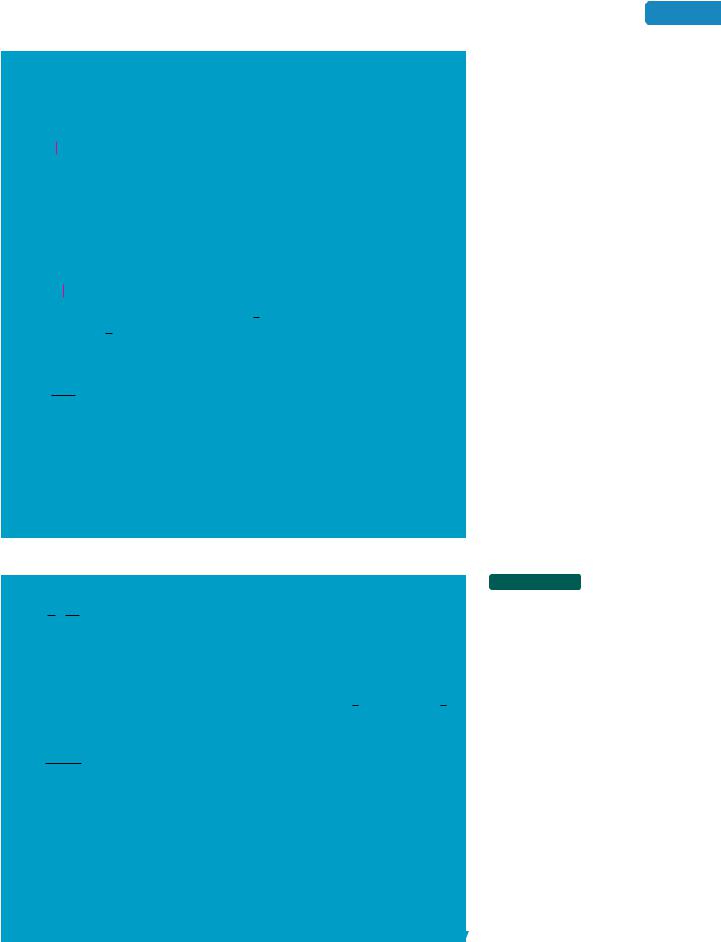
To make the comparison of the decimals easier, we can write one zero after 8 so that they have the same number of digits to the right of the decimal point.
0. 8 0 This is the decimal equivalent for 54 .
0. 9 1
As we work from left to right, this is the first column in which the digits differ. Since 8 9, it follows that 0.80 45 is less than 0.91, and we can write 45 0.91.
b.In Example 6, we saw that 13 0.3333 . . . . To make the comparison of these repeating decimals easier, we write them so that they have the same number of
digits to the right of the decimal point.
0.3 |
5 |
55 . . . |
|
|
|
|
|
|
This is |
0.35. |
|||||||
0.3 |
3 |
33 . . . |
This is |
1 |
. |
|
|
|
3 |
||||||||
|
|
|
|
|
|
|||
As we work from left to right, this is the first column in which the digits differ. Since 5 3, it follows that 0.3555 . . . 0.35 is greater than 0.3333 . . . 13 , and we can write 0.35 13 .
c. To write 94 as a decimal, we divide 9 by 4.
2.25
4 9.00 Write a decimal point and two additional zeros to the right of 9.
8
1 0
8 20
20 0
From the division, we see that 94 2.25.
 EXAMPLE 9 Write the numbers in order from smallest to largest: 2.168, 2 16 , 209
EXAMPLE 9 Write the numbers in order from smallest to largest: 2.168, 2 16 , 209
Strategy We will write 216 and 209 in decimal form.
WHY Then we can do a column-by-column comparison of the numbers to determine the largest and smallest.
Solution From the number line on page 378, we see that 16 0.16. Thus, 216 2.16. To write 209 as a decimal, we divide 20 by 9.
2.222
|
Write a decimal point and three additional zeros to the right of 20. |
9 20.000 |
18 20
18 20
18 20
18 2
Thus, 209 2.222 . . . .
|
4.5 Fractions and Decimals |
379 |
|
|
|
|
|
|
 Self Check 9
Self Check 9
Write the numbers in order from smallest to largest: 1.832, 95 , 156
Now Try Problem 75

380 |
Chapter 4 Decimals |
 Self Check 10
Self Check 10
Evaluate by working in terms of fractions: 0.53 16
Now Try Problem 79
 Self Check 11
Self Check 11
Estimate the result by working in terms of decimals: 0.53 16
Now Try Problem 87
To make the comparison of the three decimals easier, we stack them as shown below.
2. |
1 |
6 |
8 |
0 |
This is 2.168 with an additional 0. |
||||||
2. |
1 |
6 |
6 |
6 . . . |
This is |
2 |
1 |
|
|
|
|
2.16. |
|
||||||||||
|
|||||||||||
|
|
|
|
|
|
6 |
|
|
|
||
2. |
2 |
2 2 2 . . . |
This is |
20. |
|
|
|
||||
|
|
|
|
|
|
9 |
|
|
|
||
Working from left to right, this is |
|
|
|
Working from left to right, this is the |
|||||
|
|
||||||||
the first column in which the |
|
|
|
first column in which the top two |
|||||
digits differ. Since 2 1, it |
|
|
|
numbers differ. Since 8 6, it follows |
|||||
follows that 2.222 . . . 20 is |
|
|
|
that 2.168 is the next largest number |
|||||
9 |
|
|
|
|
|
|
1 |
|
|
the largest of the three numbers. |
|
|
|
and that 2.16 |
2 |
is the smallest. |
|||
|
|||||||||
|
6 |
||||||||
Written in order from smallest to largest, we have :
216 , 2.168, 209
6 Evaluate expressions containing fractions and decimals.
Expressions can contain both fractions and decimals. In the following examples, we show two methods that can be used to evaluate expressions of this type. With the first method we find the answer by working in terms of fractions.
|
EXAMPLE 10 |
Evaluate |
1 |
0.27 by working in terms of fractions. |
|
|
3 |
||
|
|
Strategy We will begin by writing 0.27 as a fraction.
WHY Then we can use the methods of Chapter 3 for adding fractions with unlike denominators to find the sum.
Solution To write 0.27 as a fraction, it is helpful to read it aloud as “twenty-seven hundredths.”
13 0.27 13 10027
13 100100 10027 33
100300 30081
181300
Replace 0.27 with 10027 .
The LCD for 31 and 10027 is 300. To build each fraction so that its denominator is 300,
multiply by a form of 1.
Multiply the numerators.
Multiply the denominators.
Add the numerators and write the sum over the common denominator 300.
Now we will evaluate the expression from Example 10 by working in terms of decimals.
|
EXAMPLE 11 |
Estimate |
1 |
0.27 by working in terms of decimals. |
|
|
3 |
||
|
|
Strategy Since 0.27 has two decimal places, we will begin by finding a decimal approximation for 13 to two decimal places.
WHY Then we can use the methods of this chapter for adding decimals to find the sum.
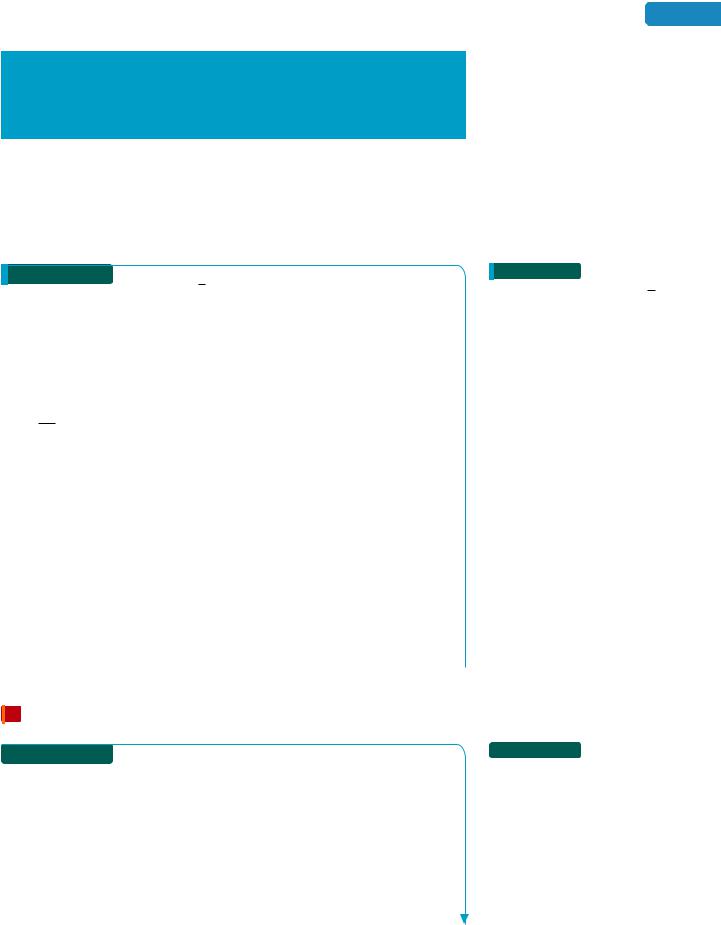
4.5 Fractions and Decimals |
381 |
Solution We have seen that the decimal equivalent of 13 is the repeating decimal 0.333 . . . . Rounded to the nearest hundredth: 13 0.33.
1 |
0.27 0.33 |
0.27 |
|
1 |
|
|
1 |
|
|
|
|
||||||
|
|
|
0.33 |
|
||||
3 |
Approximate 3 with the decimal 0.33. |
|
|
|||||
|
0.27 |
|
||||||
|
|
|
|
|
|
|
|
|
|
0.60 |
|
Do the addition. |
|
0.60 |
|
||
|
|
|
||||||
|
|
|
|
|||||
In Examples 10 and 11, we evaluated 13 0.27 in different ways. In Example 10, we obtained the exact answer, 181300 . In Example 11, we obtained an approximation, 0.6. The results seem reasonable when we write 181300 in decimal form: 181300 0.60333 . . . .
Evaluate: a45b(1.35) (0.5)2
Strategy We will find the decimal equivalent of 45 and then evaluate the expression in terms of decimals.
WHY Its easier to perform multiplication and addition with the given decimals than it would be converting them to fractions.
Solution We use division to find the decimal equivalent of 45 .
0.8
5 4.0
Write a decimal point and one additional zero to the right of the 4.
4 0 0
Now we use the order of operation rule to evaluate the expression.
a |
4 |
b(1.35) (0.5)2 |
|
|
|
|
|
|
|
|
|
||
5 |
|
|
2 |
|
||
|
|
|
|
|
||
(0.8)(1.35) (0.5)2 |
Replace 54 with its decimal equivalent, 0.8. |
0.5 |
|
|||
0.5 |
|
|||||
(0.8)(1.35) 0.25 |
Evaluate: (0.5)2 0.25. |
0.25 |
|
|||
2 |
4 |
|
||||
|
|
|
|
|
||
1.08 0.25 |
Do the multiplication: (0.8)(1.35) 1.08. |
1.35 |
|
|||
1.33 |
Do the addition. |
|
0.8 |
|
||
1.080 |
|
|||||
|
|
|
|
|
1 |
|
|
|
|
|
1.08 |
|
|
|
|
|
|
0.25 |
|
|
|
|
|
|
1.33 |
|
|
Self Check 12
Evaluate: ( 0.6)2 (2.3)a18b
Now Try Problem 99
7 Solve application problems involving fractions and decimals.
|
EXAMPLE 13 |
Shopping A shopper purchased |
3 |
|
|
|
|
4 pound of fruit, priced |
|
|
|
|
||
at $0.88 a pound, and 31 pound of fresh-ground coffee, selling for $6.60 a pound. |
||||
Find the total cost of these items. |
|
|||
Analyze |
|
|
||
|
• 43 |
pound of fruit was purchased at $0.88 per pound. |
Given |
|
|
• 1 |
pound of coffee was purchased at $6.60 per pound. |
Given |
|
3 |
|
|
|
|
|
• What was the total cost of the items? |
Find |
||
Form To find the total cost of each item, multiply the number of pounds purchased by the price per pound.
 Self Check 13
Self Check 13
DELICATESSENS A shopper purchased 23 pound of Swiss cheese, priced at $2.19 per pound, and 34 pound of sliced turkey, selling for $6.40 per pound. Find the total cost of these items.
Now Try Problem 111

382 |
Chapter 4 Decimals |
The total cost of the items
The total cost of the items
|
the number |
|
|
|
the number |
|
|
|||||
is equal to |
times |
the price |
plus |
times |
the price |
|||||||
of pounds |
of pounds |
|||||||||||
per pound |
per pound |
|||||||||||
|
of fruit |
|
|
of coffee |
|
|||||||
|
|
|
|
|
|
|||||||
|
|
|
|
|
|
|||||||
|
|
|
|
|
|
|
|
|
|
|||
|
|
3 |
|
|
$0.88 |
|
|
1 |
|
|
$6.60 |
|
4 |
|
3 |
|
|||||||||
|
|
|
|
|
|
|
|
|||||
Solve Because 0.88 is divisible by 4 and 6.60 is divisible by 3, we can work with the decimals and fractions in this form; no conversion is necessary.
31
40.88 3 6.60
|
3 |
|
0.88 |
1 |
|
6.60 |
|
0.88 |
|
6.60 |
|||
|
4 |
|
|
1 |
|
3 |
|
1 |
Express 0.88 as |
1 |
and 6.60 as |
1 . |
|
|
2.64 |
|
6.60 |
|
|
|
Multiply the numerators. |
|
|||||
|
4 |
|
3 |
|
|
|
|
Multiply the denominators. |
|
||||
0.66 2.20 |
|
|
|
Do each division. |
|
|
|
||||||
2.86 |
|
|
|
|
|
|
Do the addition. |
|
|
|
|||
State The total cost of the items is $2.86.
2
0.88 |
|
|
|
3 |
|
|
|
2.64 |
|
|
|
0.66 |
2.20 |
||
4 |
2.64 |
3 |
6.60 |
2 4 |
6 |
||
24 |
06 |
||
24 |
6 |
||
0 |
00 |
||
|
|
0 |
|
0
0.662.20 2.86
Check If approximately 1 pound of fruit, priced at approximately $1 per pound, was purchased, then about $1 was spent on fruit. If exactly 13 of a pound of coffee, priced at approximately $6 per pound, was purchased, then about 13 $6, or $2, was spent on coffee. Since the approximate cost of the items $1 $2 $3, is close to the result, $2.86, the result seems reasonable.
ANSWERS TO SELF CHECKS
|
|
|
|
|
|
|
|
|
|
|
|
|
|
|
|
|
|
1. |
a. 0.5 |
b. 0.1875 |
c. 4.5 2. |
a. 0.4 |
b. 0.32 |
3. |
3.85 |
4. |
0.083 5. 0.39 6. 0.44 |
||||||||
7. |
0.292 |
8. |
a. |
b. c. |
9. |
9 |
, 1.832, 1 |
5 |
10. |
209 |
11. |
approximately 0.36 |
|||||
12. 0.6475 |
13. $6.26 |
|
5 |
|
|
6 |
|
300 |
|
|
|
|
|
|
|||
|
|
|
|
|
|
|
|
|
|
|
|
|
|||||
|
S E C T I O N |
4.5 |
STUDY SET |
|
|
|
|
|
|
|
|
|
|
|
|
|
||||||
|
|
VOCABULARY |
|
|
|
|
|
|
|
CONCEPTS |
|
|
|
|
||||||||
|
|
|
|
|
|
|
|
|
|
|
|
|
||||||||||
|
|
|
|
|
|
|
|
|
|
|
|
|
||||||||||
|
Fill in the blanks. |
|
|
|
|
|
|
|
|
Fill in the blanks. |
|
|
|
|
||||||||
|
1. |
A fraction and a decimal are said to be |
|
|
|
if |
5. |
7 means 7 |
|
|
|
|
||||||||||
|
|
|
|
|
8. |
|
|
|||||||||||||||
|
|
|
they name the same number. |
|
|
|
|
|
8 |
|
|
|
|
|
|
|
||||||
|
|
|
|
|
|
6. |
To write a fraction as a decimal, divide the |
|||||||||||||||
|
|
|
|
|
|
equivalent of 43 is 0.75. |
|
|
|
|||||||||||||
|
2. |
The |
|
|
|
|
|
|
|
|
|
|
|
of the fraction by its denominator. |
||||||||
|
|
|
|
|
|
|
|
|
|
|
|
|||||||||||
|
|
|
|
|
|
|
|
|
|
|
|
|||||||||||
|
3. |
0.75, 0.625, and 3.5 are examples of |
|
|
|
7. |
To perform the division shown below, a decimal |
|||||||||||||||
|
|
|
decimals. |
|
|
|
|
|
|
|
|
|
|
point and two additional |
|
were written to the |
||||||
|
|
|
|
|
|
|
|
|
|
|
|
|
|
|||||||||
|
4. |
0.3333 . . . and 1.666 . . . are examples of |
|
|
|
|
|
right of 3. |
|
|
|
|
||||||||||
|
|
|
|
|
|
|
|
|
|
|
|
|
|
|||||||||
|
|
|
decimals. |
|
|
|
|
|
|
|
|
|
|
|
|
|
|
|
|
|
|
|
|
|
|
|
|
|
|
|
|
|
|
|
|
4 3.00 |
|
|
|
|
|||||
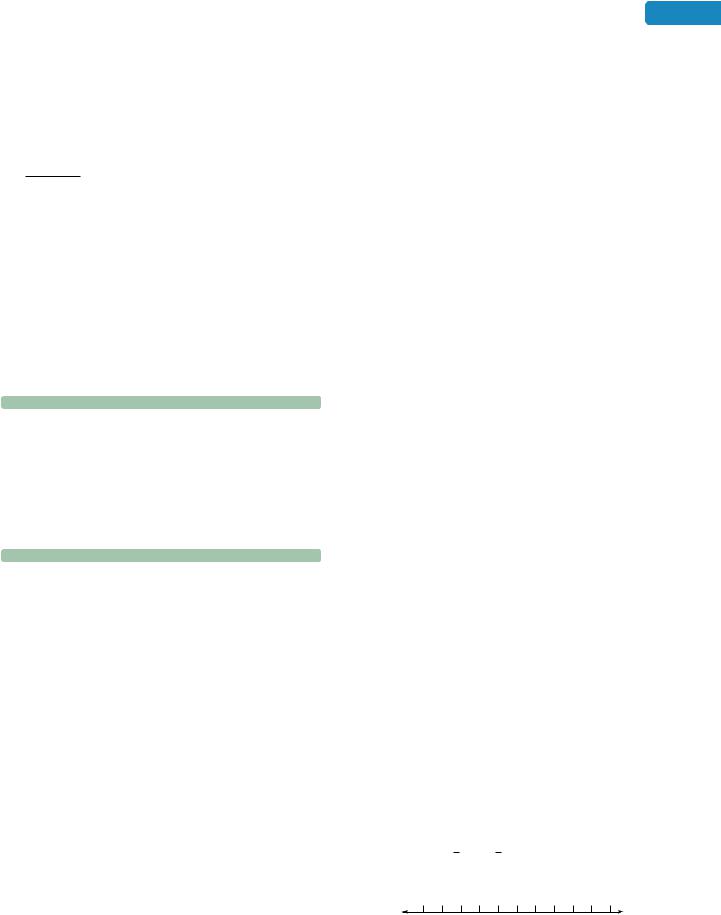
8.Sometimes, when finding the decimal equivalent of a fraction, the division process ends because a remainder of 0 is obtained. We call the resulting
decimal a |
|
decimal. |
9.Sometimes, when we are finding the decimal equivalent of a fraction, the division process never gives a remainder of 0. We call the resulting decimal a
decimal.
10.If the denominator of a fraction in simplified form has factors of only 2’s or 5’s, or a combination of both, it can be written as a decimal by multiplying it by a form of  .
.
11.a. Round 0.3777 . . . to the nearest hundredth.
b.Round 0.212121 . . . to the nearest thousandth1 . 2
12.a. When evaluating the expression 0.25 2.3 25 2, would it be easier to work in terms of fractions or
decimals?
b.What is the first step that should be performed to evaluate the expression?
 NOTATION
NOTATION
13. Write each decimal in fraction form.
a. 0.7 |
b. 0.77 |
14.Write each repeating decimal in simplest form using an overbar.
a. |
0.888 . . . |
b. |
0.323232 . . . |
c. |
0.56333 . . . |
d. |
0.8898989 . . . |
 GUIDED PRACTICE
GUIDED PRACTICE
Write each fraction as a decimal. See Example 1.
15. |
1 |
|
|
|
16. |
1 |
|
|
|
2 |
|
|
|
4 |
|
|
|
||
17. |
7 |
|
|
|
18. |
3 |
|
|
|
|
|
|
|
|
|
|
|
||
8 |
|
|
|
8 |
|
|
|
||
19. |
11 |
|
20. |
17 |
|
||||
|
|
|
|
|
|
||||
20 |
|
20 |
|
||||||
21. |
13 |
|
22. |
15 |
|
||||
5 |
|
|
2 |
|
|
||||
23. |
9 |
|
|
24. |
3 |
|
|
||
16 |
|
32 |
|
||||||
25. |
17 |
26. |
15 |
||||||
|
|
|
|
|
|
||||
32 |
16 |
||||||||
Write each fraction as a decimal using multiplication by a form of 1. See Example 2.
27. |
3 |
|
28. |
13 |
5 |
|
25 |
||
29. |
9 |
30. |
7 |
|
|
|
|
||
40 |
40 |
|||
|
4.5 |
Fractions and Decimals |
383 |
|||||
31. |
19 |
|
|
32. |
21 |
|
|
|
25 |
|
|
50 |
|
|
|
||
33. |
1 |
|
|
34. |
1 |
|
|
|
500 |
|
250 |
|
|
||||
Write each mixed number in decimal form. See Example 3.
35. |
3 |
3 |
|
|
36. |
5 |
4 |
|
|
4 |
|
|
5 |
|
|
||||
37. |
12 |
11 |
38. |
32 |
9 |
||||
16 |
16 |
||||||||
Write each fraction as a decimal. Use an overbar in your answer.
See Example 4.
39. |
1 |
|
40. |
8 |
|
9 |
|
9 |
|
||
41. |
7 |
42. |
11 |
||
12 |
12 |
||||
43. |
7 |
44. |
1 |
||
90 |
99 |
||||
45. |
1 |
46. |
1 |
||
|
|
|
|
||
60 |
66 |
||||
Write each fraction as a decimal. Use an overbar in your answer.
See Example 5.
47. |
|
5 |
48. |
|
7 |
11 |
11 |
||||
49. |
|
20 |
50. |
|
16 |
|
|
||||
33 |
33 |
Write each fraction in decimal form. Round to the nearest hundredth. See Example 6.
51. |
7 |
|
|
52. |
8 |
|
|
|
30 |
|
9 |
|
|
|
|||
53. |
22 |
|
54. |
17 |
|
|||
45 |
|
45 |
|
|||||
55. |
24 |
|
56. |
34 |
|
|||
|
|
|
|
|
||||
13 |
|
11 |
|
|||||
57. |
13 |
58. |
25 |
|||||
|
|
|
|
|
|
|||
12 |
12 |
|||||||
Write each fraction in decimal form. Round to the nearest thousandth. See Example 7.
59. |
5 |
60. |
5 |
33 |
24 |
||
61. |
10 |
62. |
17 |
|
|
||
27 |
21 |
Graph the given numbers on a number line. See Objective 4.
63. 134 , 0.75, 0.6, 3.83
−5 − 4 −3 −2 −1 0 1 2 3 4 5
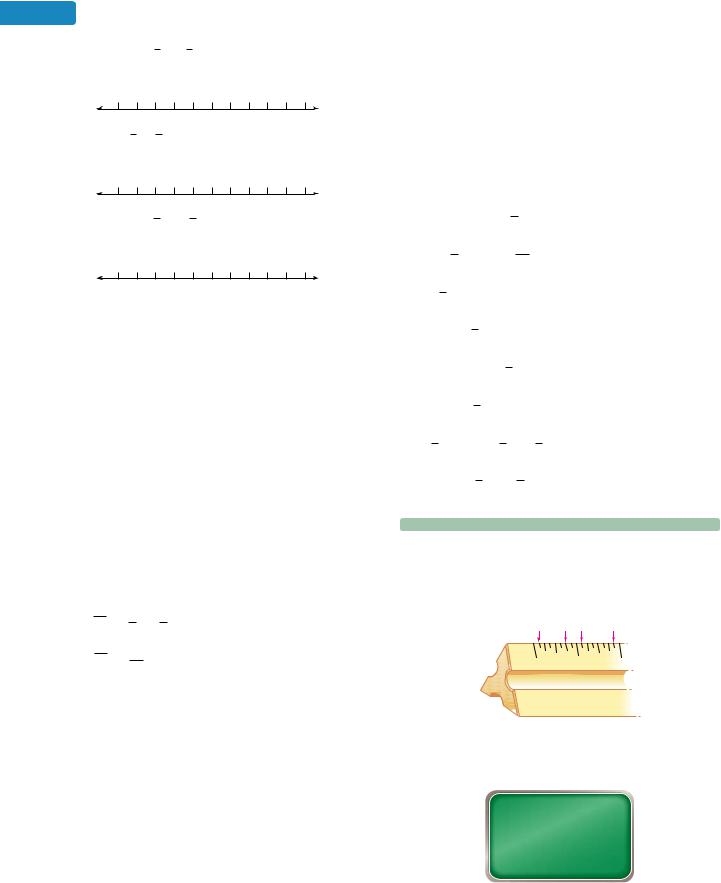
384 |
Chapter 4 Decimals |
64. 278 , 2.375, 0.3, 4.16
−5 − 4 −3 −2 −1 0 1 2 3 4 5
65. 3.875, 3.5, 0.2, 145
−5 − 4 −3 −2 −1 0 1 2 3 4 5
66. 1.375, 417 , 0.1, 2.7
−5 − 4 −3 −2 −1 0 1 2 3 4 5
Place an , , or an symbol in the box to make a true statement. See Example 8.
67. |
7 |
|
|
|
|
|
0.895 |
|
68. |
3 |
|
|
|
|
0.381 |
|
|||||||||||
|
|
|
|
|
|
|
|
|
|||||||||||||||||||
8 |
|
|
|
|
|
|
8 |
|
|
|
|
|
|||||||||||||||
|
|
|
|
|
|
|
|
17 |
|
|
|
|
|
|
|
|
|
7 |
|
|
|||||||
|
|
|
|
|
|
|
|
|
|
|
|
|
|
|
|
|
|
|
|
||||||||
69. |
0.7 |
|
|
|
|
70. |
0.45 |
|
|
|
|
||||||||||||||||
|
|
|
|
22 |
|
|
|
|
16 |
|
|
||||||||||||||||
|
|
|
|
|
|
|
|
|
|
|
|
|
|
|
|
|
|
|
|
||||||||
71. |
52 |
|
|
|
|
2.08 |
|
72. |
4.4 |
|
|
22 |
|
|
|
||||||||||||
|
|
|
|
|
|
|
|
|
|||||||||||||||||||
25 |
|
|
|
|
|
|
|
5 |
|
|
|
||||||||||||||||
|
|
|
|
|
|
|
|
|
|
|
|
|
|
|
|
|
|
|
|
||||||||
|
11 |
|
|
|
|
|
|
|
|
|
|
|
|
|
|
|
|
|
|
|
1 |
||||||
73. |
|
|
|
|
|
|
|
|
|
0.48 |
74. |
0.09 |
|
|
|
|
|
||||||||||
20 |
11 |
||||||||||||||||||||||||||
|
|
|
|
|
|
|
|
|
|
|
|
|
|
|
|
|
|
|
|
||||||||
Write the numbers in order from smallest to largest.
See Example 9.
75. |
6 |
1 |
, |
6.25, |
19 |
2 |
3 |
||||
76. |
7 |
3 |
, |
7.08, |
43 |
|
|
||||
8 |
6 |
86
77.0.81, 9 , 7
1
78. 0.19, 11 , 0.1
Evaluate each expression. Work in terms of fractions.
See Example 10.
79. |
1 |
0.3 |
|
|
|
80. |
2 |
0.1 |
|
|
||||
9 |
|
|
|
3 |
|
|
||||||||
|
|
7 |
|
|
|
|
5 |
|
|
|||||
81. |
0.9 |
|
|
|
82. |
0.99 |
|
|
|
|||||
12 |
|
6 |
|
|
||||||||||
|
5 |
|
|
|
|
|
|
|
1 |
|
|
|||
83. |
|
(0.3) |
|
|
|
84. |
(0.9)a |
|
|
|
b |
|||
11 |
|
|
|
27 |
||||||||||
85. |
1 |
(0.25) |
|
15 |
86. |
2 |
(0.02) (0.04) |
|||||||
|
|
|
||||||||||||
4 |
16 |
5 |
||||||||||||
Estimate the value of each expression. Work in terms of decimals. See Example 11.
87. 0.24 |
1 |
88. 0.02 |
5 |
3 |
6 |
89. |
5.69 |
5 |
90. |
3.19 |
2 |
|
||
12 |
3 |
|
||||||
91. |
0.43 |
1 |
92. |
0.27 |
5 |
|||
12 |
12 |
|||||||
93. |
1 |
0.55 |
94. |
7 |
0.84 |
|||
|
|
|||||||
15 |
30 |
|||||||
Evaluate each expression. Work in terms of decimals.
See Example 12.
95.(3.5 6.7)a 14b
96.a 58ba5.3 3 109 b
2
97. a15b (1.7)
2
98. (2.35)a25b
2
99. 7.5 (0.78)a12b
2
100. 8.1 a34b (0.12)
101. 38 (3.2) a4 12ba 14b
102. ( 0.8)a14b a15b(0.39)
 APPLICATIONS
APPLICATIONS
103.DRAFTING The architect’s scale shown below has several measuring edges. The edge marked 16 divides each inch into 16 equal parts. Find the
decimal form for each fractional part of 1 inch that is highlighted with a red arrow.
16
0 |
1 |
104.MILEAGE SIGNS The freeway sign shown below gives the number of miles to the next three exits. Convert the mileages to decimal notation.
Barranca Ave. |
|
3 |
|
– mi |
|
|
|
4 |
210 Freeway |
2 |
1 |
– mi |
||
|
|
4 |
Ada St. |
3 |
1 |
– mi |
||
|
|
2 |
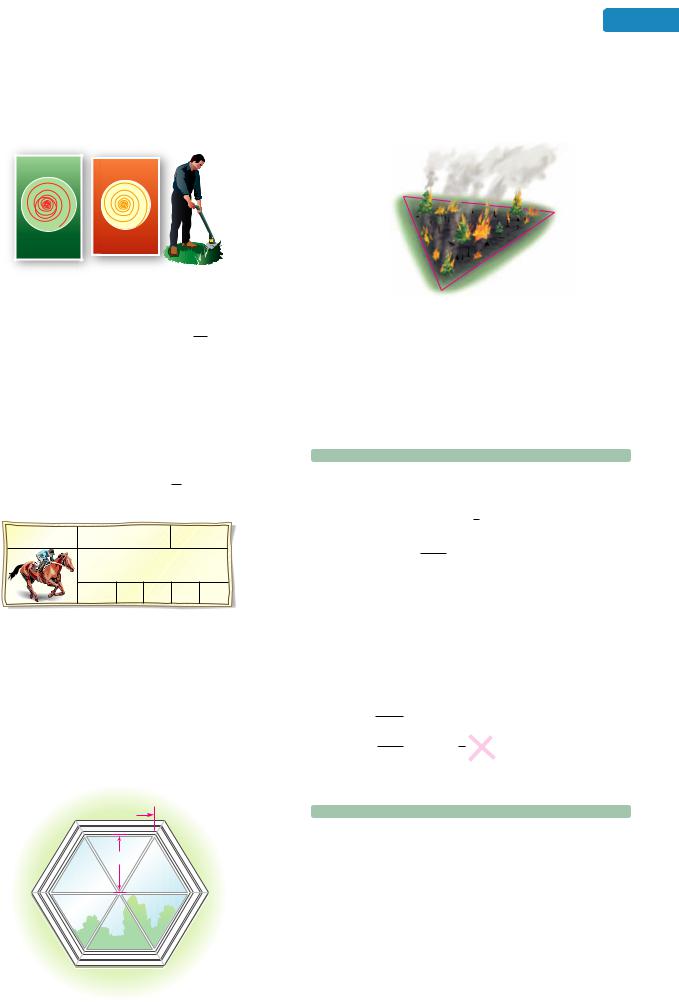
105.GARDENING Two brands of replacement line for a lawn trimmer shown below are labeled in different ways. On one package, the line’s thickness is expressed as a decimal; on the other, as a fraction. Which line is thicker?
NYLON LINE |
TRIMMER |
|
LINE |
Thickness: |
3 |
–– in. thick |
|
0.065 in. |
40 |
|
106.AUTO MECHANICS While doing a tune-up, a mechanic checks the gap on one of the spark plugs
of a car to be sure it is firing correctly. The owner’s manual states that the gap should be 1252 inch. The gauge the mechanic uses to check the gap is in
decimal notation; it registers 0.025 inch. Is the spark plug gap too large or too small?
107.HORSE RACING In thoroughbred racing, the time a horse takes to run a given distance is
measured using fifths of a second. For example, :232 (read “twenty-three and two”) means 2325 seconds. The illustration below lists four split times for a horse named Speedy Flight in a 1161 -mile race. Express each split time in decimal form.
Speedy Flight |
Turfway Park, Ky |
3-year–old |
|||
|
17 May 2010 |
|
1 |
|
|
|
|
1 –– mile |
|||
|
|
|
|
16 |
|
|
Splits |
:232 |
:234 |
:241 |
:323 |
108.GEOLOGY A geologist weighed a rock sample at
the site where it was discovered and found it to weigh 1778 lb. Later, a more accurate digital scale in the laboratory gave the weight as 17.671 lb. What is
the difference in the two measurements?
109.WINDOW REPLACEMENTS The amount of sunlight that comes into a room depends on the area of the windows in the room. What is the area of the
window shown below? (Hint: Use the formula
A 12 bh.)
 6 in.
6 in.
5.2 in.
4.5 Fractions and Decimals |
385 |
110.FORESTRY A command post asked each of three fire crews to estimate the length of the fire line they were fighting. Their reports came back in different forms, as shown. Find the perimeter of the fire. Round to the nearest tenth.
North flank 1.9 mi
West flank
1
1– mile East flank
8
2
1– mile
3
111.DELICATESSENS A shopper purchased 23 pound of green olives, priced at $4.14 per pound, and 34 pound of smoked ham, selling for $5.68 per pound. Find the total cost of these items.
112.CHOCOLATE A shopper purchased 34 pound
of dark chocolate, priced at $8.60 per pound, and 13 pound of milk chocolate, selling for $5.25 per pound. Find the total cost of these items.
 WRITING
WRITING
113.Explain the procedure used to write a fraction in decimal form.
114.How does the terminating decimal 0.5 differ from the repeating decimal 0.5?
115.A student represented the repeating decimal 0.1333 . . . as 0.1333. Is this the best form? Explain why or why not.
116.Is 0.10100100010000 . . . a repeating decimal? Explain why or why not.
117.A student divided 19 by 25 to find the decimal equivalent of 1925 to be 0.76. Explain how she can check this result.
118.Explain the error in the following work to find the decimal equivalent for 56 .
1.2
5 6.0
5
1010 0
Thus,
 REVIEW
REVIEW
119.Write each set of numbers.
a.the first ten whole numbers
b.the first ten prime numbers
c.the integers
120.Give an example of each property.
a.the commutative property of addition
b.the associative property of multiplication
c.the multiplication property of 1
